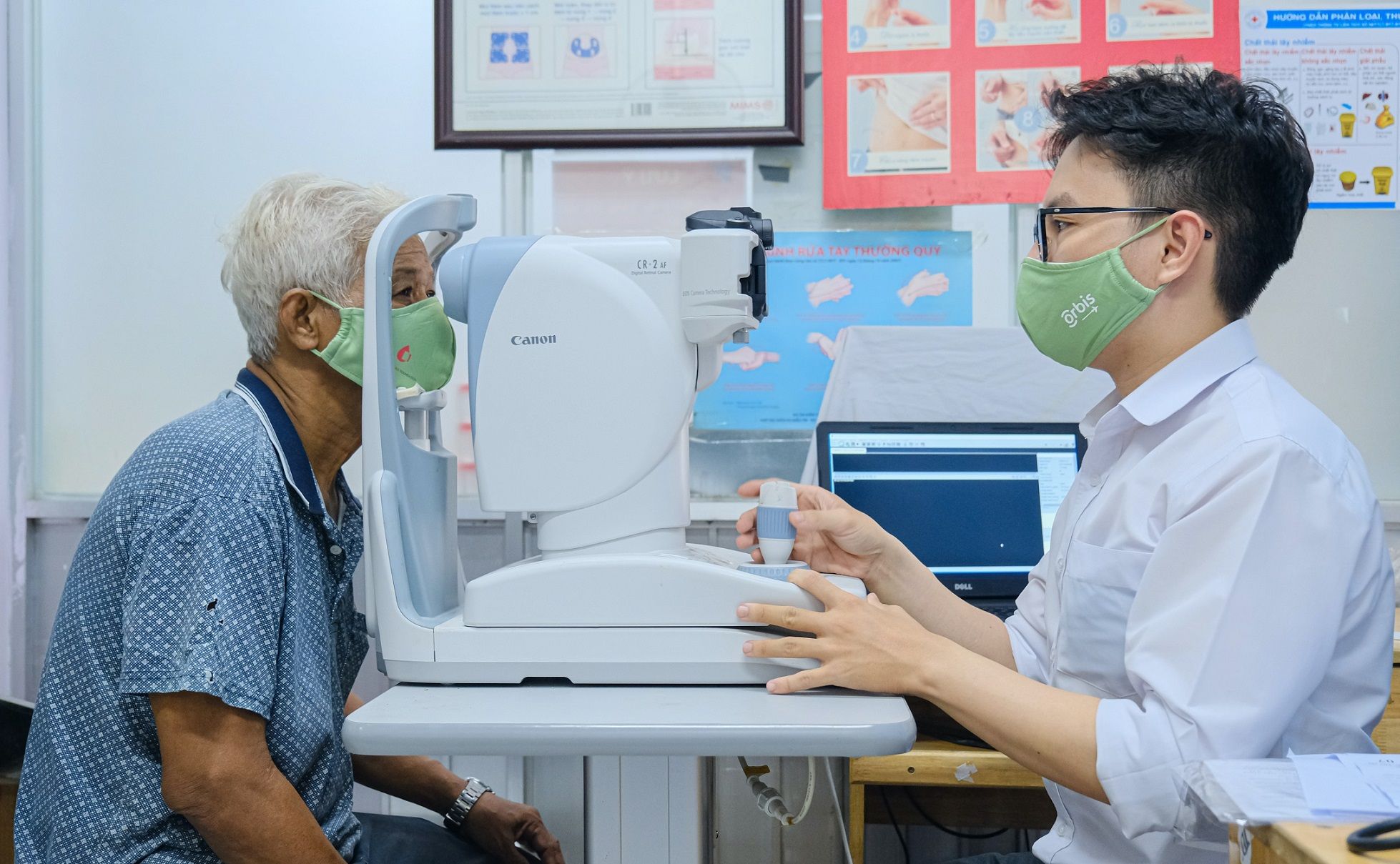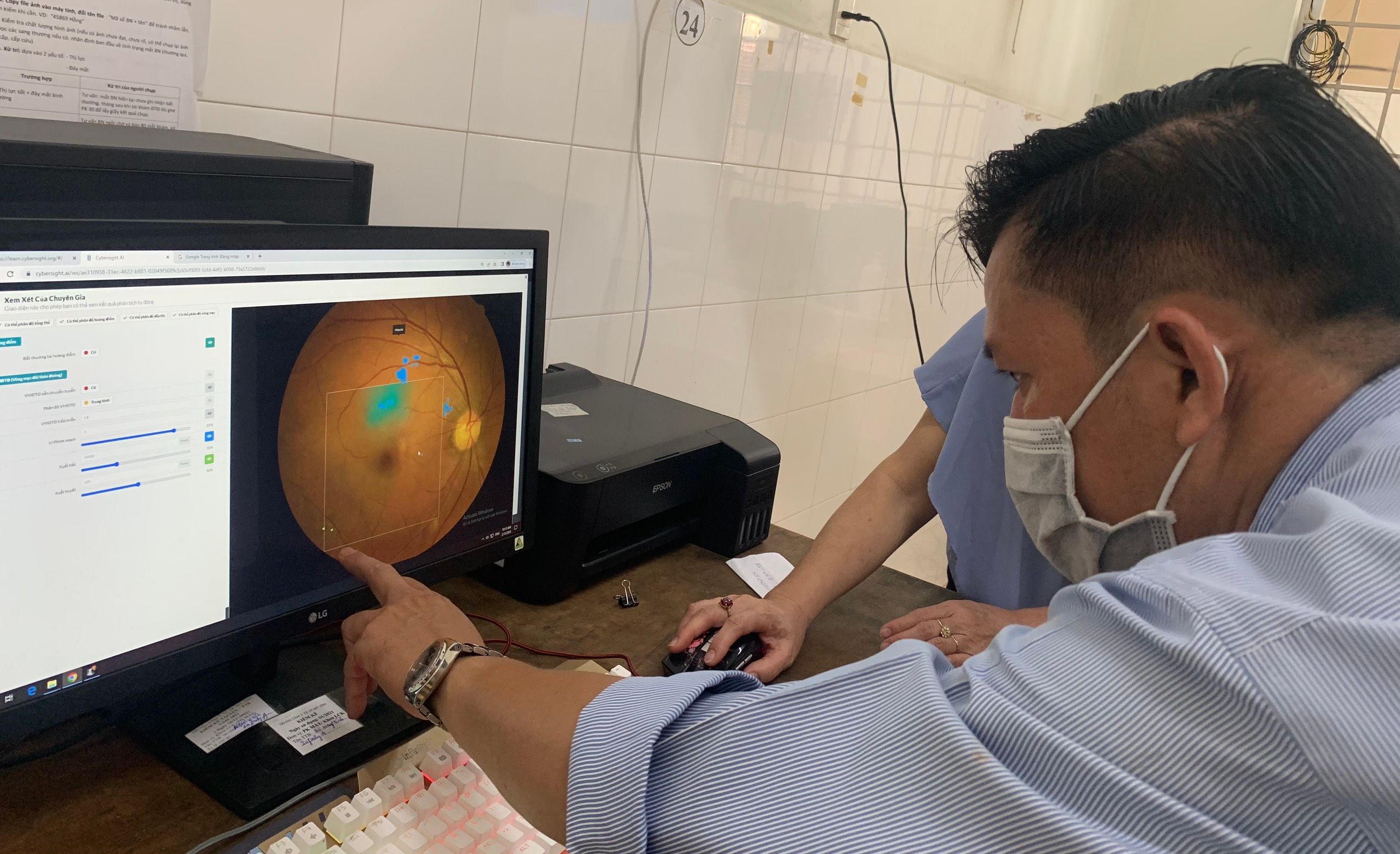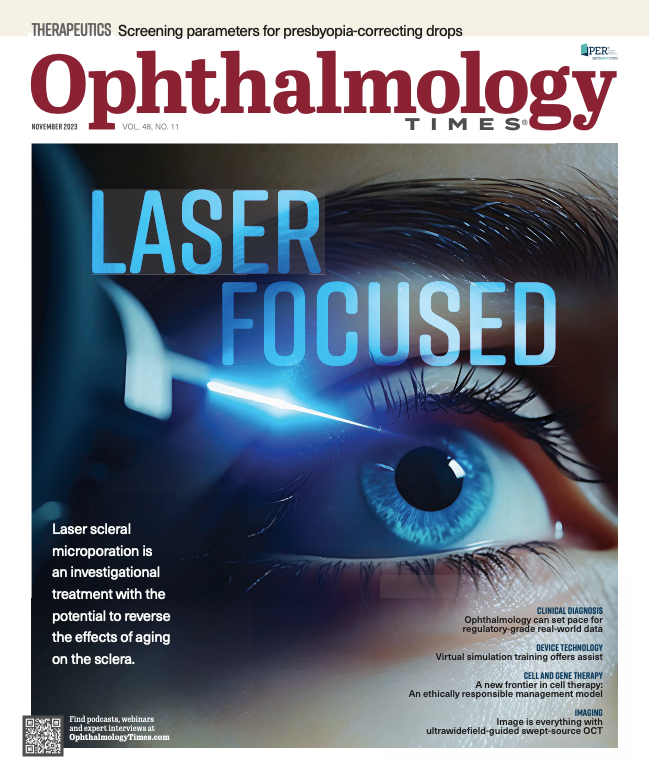Article
News
Digital Edition
Providing comprehensive eye care for diabetic patients in southern Vietnam
Author(s):
Community-based eye care is one of Orbis’s top priorities in the country.
An eye doctor at Orbis Vietnam’s partner hospital Thu Duc Hospital performs an eye examination on a patient with diabetes. (Images courtesy of Orbis International)

As of 2021, 537 million people live with diabetes around the world, according to the International Diabetes Federation Diabetes Atlas. This number is predicted to rise to 645 million by 2030 and 783 million by 2045. The disease most affects low- and middle-income countries, where resources are limited.
Vietnam, a middle-income country, has a high prevalence of diabetes that continues to grow at a worrying rate. In the past 20 years, the prevalence of diabetes has increased from 2.7% of the population (between 30 and 69 years of age) to 7.3%—approximately 5 million people in 2022—as reported by Vietnam’s National Hospital of Endocrinology. Hanoi and Ho Chi Minh City, the 2 largest cities in the country, have the highest prevalence of diabetes, at 8.3% of their populations.
Diabetic retinopathy is an eye disease that cannot be ignored. Globally, the prevalence of the disease in diabetic patients is estimated to be 27%.¹ In Vietnam, diabetic retinopathy is one of the leading causes of blindness and vision loss, according to the Vietnam National Institute of Ophthalmology (VNIO).
Diabetic retinopathy progresses without symptoms and can result in blindness if not detected early and treated quickly. Most diabetic retinopathy patients do not have any noticeable symptoms until the disease is in the advanced stage, which can claim their vision permanently, even with treatment. In Vietnam, awareness about diabetes, diabetic retinopathy, and other eye complications is low. Many diabetic patients do not have regular eye exams and see a specialist only when they experience symptoms, at which point there is irreversible damage to their vision.
Orbis Vietnam’s approach to diabetic eye care
In 1996, Orbis International first collaborated with the eye health sector in Vietnam by providing hospital-based trainings at the VNIO, then supported the establishment of the first eye bank in Vietnam at the VNIO in 2005. In Vietnam, working in strong partnership with the government and local bodies, hospitals, universities, national and international organizations, and other partners, Orbis focuses on 4 priority areas: pediatric eye care; community-led primary eye care; human resources development; and crosscutting areas with the integration of partnership, technology, learning, equity, and people-centered care in all areas of their interventions.
Contributing to consolidating the National Target Program for Diabetes Prevention and to achieving the goal of the National Strategy on Blindness Prevention, from 2016 to 2022 Orbis Vietnam collaborated with its partners in Ho Chi Minh City and Tien Giang province to carry out a project with a comprehensive approach to providing eye care for patients with diabetes, with funding from the World Diabetes Foundation and United Parcel Service. The project was implemented at Ho Chi Minh Eye Hospital, Tien Giang Eye Hospital, 5 general hospitals in Ho Chi Minh City and Tien Giang province, and the Centers for Disease Control of Tien Giang province.
An ophthalmologist learns how to use Cybersight AI at My Tho Health Center.

A lack of trained ophthalmic staff is a major barrier to diabetic retinopathy screening in Vietnam. To address this problem, the project focused on improving the capacity of local health partners to detect and treat diabetic retinopathy in Ho Chi Minh City and Tien Giang province. Orbis Vietnam focused on training nonophthalmic medical staff to screen and detect diabetic retinopathy in the early stages of the disease. Training also included how to use fundus cameras to capture quality images of the retina, how to identify retinal lesions, and how to grade retinal images. It is critical to train nurses and community health staff to identify diabetic retinopathy to make up for the lack of trained ophthalmic staff in the country who are often available only in provincial or tertiary hospitals and facilities. The project also aimed to raise awareness among health staff and the public of the importance of early detection of diabetic retinopathy and advocated for improved policies for the comprehensive management of diabetes.
As part of this project, over 96,000 diabetic patients were screened and more than 11,000 patients received treatment for diabetic retinopathy. Nearly 140 doctors and nurses were trained in screening, management, and treatment of diabetic retinopathy, and more than 50 community health workers were trained in eye care counseling for diabetic patients.
Upon conclusion of the project, diabetic retinopathy screening services were successfully integrated into Vietnam’s diabetes mellitus management system, creating and sustaining a smooth coordination network between the eye care and the endocrinology sectors in the management of diabetic patients. As a result, diabetic patients are now screened for diabetic retinopathy by trained endocrinology or nonophthalmic staff at their regular diabetes management appointments. Patients who show signs of diabetic retinopathy are referred to an eye care specialist for continued monitoring and treatment.
Cybersight AI
In an effort to establish new and innovative approaches to overcoming the shortage of trained ophthalmic staff in the country, Orbis Vietnam implemented a trial to utilize artificial intelligence (AI) to help detect diabetic retinopathy. Globally, AI is becoming more common in screening, diagnosing, and helping to treat eye conditions. Deep integration of ophthalmology and AI has the potential to revolutionize current disease diagnosis patterns and generate a significant clinical impact.
Cybersight, Orbis’s telemedicine and e-learning platform, includes a revolutionary AI component called Cybersight AI, which not only can detect early signs of diabetic retinopathy but also can help train medical staff to detect the disease on their own. The trial took place from April to June 2022 at Tien Giang General Hospital.
The trial showed AI is an effective tool to help diagnose diabetic retinopathy in patients with diabetes. With Cybersight AI, the grading results are available 10 to 20 seconds after fundus images are uploaded, making it easier for medical staff to provide timely consultation or referral to patients where needed. The success of the trial has laid a foundation for the extension of diabetic retinopathy screening to other health facilities in Vietnam.
One of the key highlights of this project is the endorsement of the technical guidelines on diagnosis, treatment, and management of patients with diabetic retinopathy by the Ministry of Health in September 2022, which has been effective in all health care facilities across Vietnam. The issuance of these guidelines marked an important milestone in Vietnam’s health care policy. For the first time, guidelines on diagnosis, treatment, and management of diabetic retinopathy were approved, fostering the strong coordination between eye care and endocrinology in monitoring and managing care of patients with diabetic retinopathy. Accordingly, eye screenings have become a routine part of exams for patients with diabetes. The guidelines also specify the procedure for examination and early detection of diabetic retinopathy, providing rationale for health care facilities to advocate for this new service to be covered by the national health insurance.
Communication was a key part of the project. Doctors and nurses in the project sites were trained on communication and counseling skills so they could help educate patients on the risks of diabetic retinopathy and the importance of regular eye checks for the early detection of the disease. Communication and education materials were also developed and disseminated to the communities via various channels to increase awareness about the disease and general eye care. Nearly 100,000 people were reached with messages about eye care through news broadcasts and articles on diabetes and diabetic retinopathy prevention distributed through social media, radio, and loudspeaker systems.
Community-based eye care is one of Orbis’ top priorities in Vietnam over the next few years. In partnership with government and development stakeholders, Orbis Vietnam will continue to fight avoidable blindness and vision loss by focusing on their leading causes, including cataracts, refractive errors, glaucoma, and diabetic retinopathy, contributing to the goals the Vietnam National Blindness Prevention Program aims to achieve by 2030.
Ngoc Pham, MBA
E: ngoc.pham@orbis.org
As the country director for Orbis Vietnam, Ngoc Pham oversees the strategic and operational management of the Orbis country office and the fulfillment of Orbis’ mission in Vietnam. Of her 20 years working in the development sector, Pham has been working in the areas of eye health and nutrition-sensitive agriculture for 19 years. She has substantial experience working with government, local partners, and donors and has displayed a deep interest in working with women, children, and disadvantaged communities. Ngoc earned a master of business administration from Troy University in Alabama in collaboration with the Vietnam National University.
Reference:
1. Zegeye AF, Temachu YZ, Mekonnen CK. Prevalence and factors associated with diabetes retinopathy among type 2 diabetic patients at Northwest Amhara Comprehensive Specialized Hospitals, Northwest Ethiopia 2021. BMC Ophthalmol. 2023:23(1):9. doi:10.1186/s12886-022-02746-8

Newsletter
Don’t miss out—get Ophthalmology Times updates on the latest clinical advancements and expert interviews, straight to your inbox.





